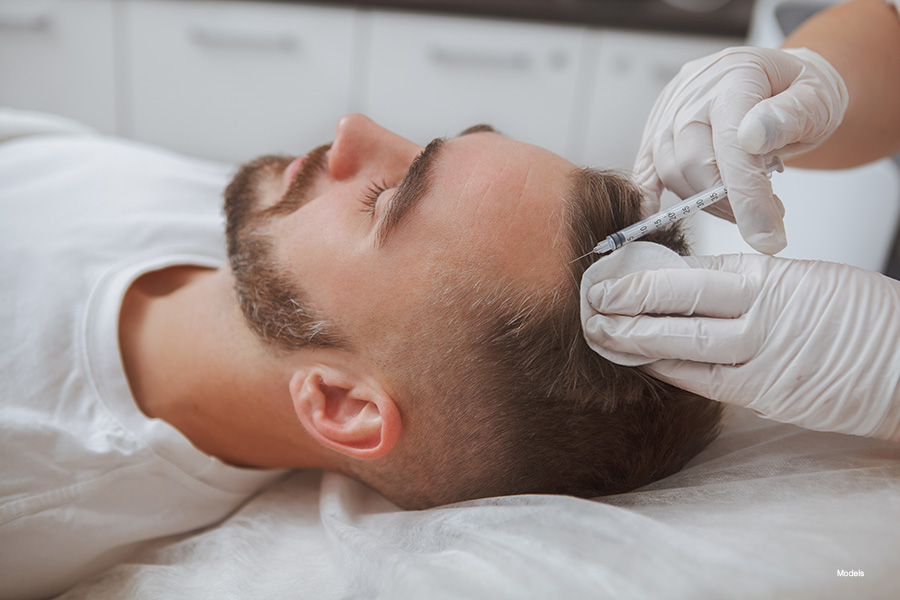Hair loss, a common concern affecting men and women, can profoundly impact self-esteem and confidence. Platelet-rich plasma (PRP) therapy has emerged as a promising solution for hair loss and restoration by stimulating natural hair regrowth. In this informative blog, we explore who can benefit most from PRP for hair loss, demystify the inner workings of this procedure, offer insights into its effectiveness, and explain the potential it holds for those seeking a fuller, healthier head of hair.

Who Can Benefit Most from PRP for Hair Loss?
Excessive or accelerated hair loss can be discouraging and embarrassing, negatively affecting self-confidence. Men and women suffer hair loss for many reasons, including genetics, stress, and hormone changes.
Thankfully, PRP for hair loss is a versatile treatment suitable for many candidates experiencing different types and stages of hair thinning.
- Androgenetic Alopecia (Genetic Hair Loss)
Individuals with androgenetic alopecia, a hereditary form of hair loss, often find PRP therapy particularly effective as it addresses the underlying factors contributing to genetic hair thinning.
- Early Stages of Hair Loss
PRP is most beneficial in the early stages of hair loss when there is still viable hair follicle activity because it can halt further hair shedding and stimulate regrowth.
- Individuals Seeking Non-Invasive Solutions
PRP for hair loss is non-invasive, making it an attractive option for individuals seeking a minimally disruptive treatment with little to no downtime.
- Those with Diffuse Hair Thinning
Individuals experiencing diffuse thinning, where hair loss is spread across the scalp rather than in specific patterns, often benefit from the overall stimulation of hair follicles provided by PRP.
Understanding the Science Behind PRP for Hair Loss
PRP for hair loss harnesses the regenerative power of platelets to promote hair follicle health and stimulate natural hair growth. The three fundamental aspects of this science are as follows:
- Derived from your blood: When choosing PRP for hair loss to stimulate hair growth, the medicinal benefits are obtained from your own blood, so there is no chance of an allergic reaction or rejection. A small sample is taken and processed to isolate the platelets containing growth factors and other bioactive substances essential for tissue repair and regeneration.
- The injection process: Once the PRP has been prepared, it is strategically injected into the scalp in areas experiencing hair thinning where the growth factors in PRP work to stimulate the activity of hair follicles, promoting an environment conducive to hair regrowth.
- PRP’s effect on hair follicles: While the growth factors in PRP activate dormant hair follicles, they also prolong the anagen phase of the hair growth cycle. This aspect of PRP helps prevent further hair loss and encourages the development of thicker, healthier hair strands.
How Does the PRP for Hair Loss Procedure Work?
PRP therapy for hair loss is a personalized and ongoing process that requires a series of sessions to achieve optimal results.
- Your consultation and evaluation: The procedure begins with a comprehensive consultation. The healthcare provider will evaluate the extent of your hair loss, assess your candidacy, and discuss realistic expectations and potential outcomes.
- Blood Draw and PRP Processing: A small amount of blood is drawn during treatment. The blood is then processed using a centrifuge to isolate and concentrate the platelets, creating the PRP solution.
- Administration of PRP: The PRP is skillfully injected into the targeted areas of the scalp using a fine needle. The process is generally well-tolerated, and the provider can minimize discomfort by applying a local anesthetic.
- Multiple sessions for ideal results: PRP therapy is typically administered in a series of sessions spaced several weeks apart. The number of sessions varies based on individual response and the extent of hair loss.
Benefits of PRP for Hair Loss
PRP therapy offers several benefits for individuals seeking a natural and effective solution to combat hair loss.
- Stimulates hair growth: – One of the primary benefits of PRP is its ability to stimulate hair follicle activity, resulting in new hair growth. PRP is particularly advantageous for individuals in the early stages of hair thinning.
- Improves hair thickness and density: – PRP promotes the development of thicker, healthier hair strands, enhancing overall hair thickness and density.
- Minimizes hair shedding: – By addressing the underlying factors contributing to hair loss, PRP therapy can help reduce hair shedding, preserve existing hair, and prevent further loss.
- Non-invasive hair loss treatment: – PRP for hair loss is a non-invasive procedure that avoids surgical interventions, making it an appealing option for those seeking a less intrusive approach to address their hair concerns.
The Best PRP Candidates Have Realistic Expectations
While PRP therapy for hair loss holds immense potential, it’s essential to have realistic expectations and consider various factors.
Visible results from PRP therapy may take several months to become noticeable. Patience is vital, as the process involves your hair’s natural growth cycle.
Maintenance sessions are often recommended at intervals determined by the healthcare provider to sustain the benefits of PRP. These sessions help support ongoing hair health and growth.
Combining PRP for Hair Loss With Other Restoration Treatments
In some cases, PRP therapy may be combined with other hair loss treatments for enhanced results. Consultation with a qualified healthcare provider helps determine the most suitable approach for individual needs.
PRP for Hair Loss in Miami, FL
Dr. Leonard Hochstein is a board-certified plastic surgeon who provides quality PRP for hair loss in Miami, Florida, along with DE/RIVE, NUTRAFOL, and other effective treatments. Please call our Miami office to learn more about your Miami hair restoration options at (786) 802-6699